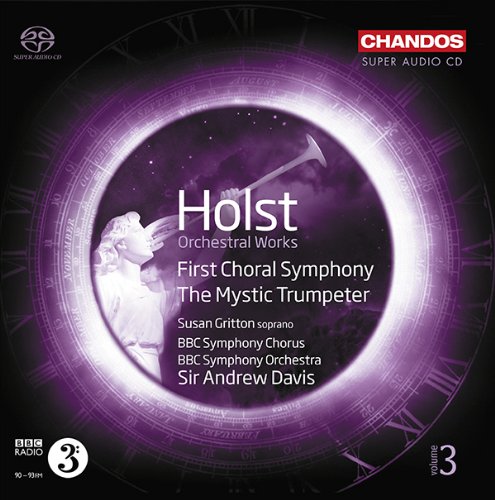HOLST First Choral Symphony. The Mystic Trumpeter
View record and artist detailsRecord and Artist Details
Composer or Director: Gustav Holst
Genre:
Vocal
Label: Chandos
Magazine Review Date: 12/2013
Media Format: Super Audio CD
Media Runtime: 69
Mastering:
DDD
Catalogue Number: CHSA5127

Tracks:
| Composition | Artist Credit |
|---|---|
| (The) Mystic Trumpeter |
Gustav Holst, Composer
Andrew Davis, Conductor BBC Symphony Orchestra Gustav Holst, Composer Susan Gritton, Soprano |
| (First) Choral Symphony |
Gustav Holst, Composer
Andrew Davis, Conductor BBC Symphony Chorus BBC Symphony Orchestra Gustav Holst, Composer Susan Gritton |
Author: Andrew Mellor
Lise Davidsen’s name pings out of the album cover but make no mistake, its real star is the Bergen Philharmonic Orchestra’s string section. Edward Gardner’s performance of the three-movement string-orchestra version of Sibelius’s Rakastava manages to combine something of the dark soil referred to by the composer with the sense of music well sprung and theatrically lit, particularly in the kinetic energy of the second section, ‘The Way of the Lover’. ‘Good Night, Farewell’ has intensity but not density, with beautifully taken solos and telling, hovering pauses.
Bergen’s woody, thoroughbred strings are most identifiable in ‘The Death of Mélisande’, which wraps up the composer’s nine-movement suite from his own incidental music to Maeterlinck’s play. This is the same tenderness and translucence that the Bergen orchestra is famed for bringing to the equivalent moment in Grieg’s Peer Gynt, but the string sound is just as cultivated in the second movement, ‘Mélisande’, and the third, ‘At the Seashore’. Davidsen creates a spellbinding atmosphere of plain-spoken understatement in the modest ballad ‘The Three Blind Sisters’. This is an account of the suite that combines considered animation with serious thought about colour, while the best is made of Sibelius’s miniature tone poem Vårsång.
Luonnotar is a different prospect but, again, Davidsen’s delivery is less storytelling than stentorian. She doesn’t turn her mouth around the Finnish words, her floated notes aren’t all that settled and the melodic fragmentation that takes root around 2'00" can feel a little awkward. A magnificent voice but a less than ideal fit; turn to Helena Juntunen with Osmo Vänskä and you hear a lighter, floatier instrument that can blossom from small seeds into ringing openness, which suits the architecture of the music better. That doesn’t stop the creamy purity of Davidsen’s final incantation over harp and strings providing a moment to savour.
The vertical detail and surging power of Gardner’s orchestra in Luonnotar bodes well for Tapiola. Gardner does a good line in proto-spectralist colour-matching (low winds at 5'50"), and again the strings excel themselves (naturally embracing at 9'30", eerie at 10'15"). But there is something calculated that nulls the swaying arboreous vertigo at 2'00", undermines the power of the gathering storm and removes the throb from that crepuscular final B major chord, neither sending a warm chill up the spine nor giving the impression of music unfolding at the mercy of nature. Perhaps there is some settling – some living – still to do before this team can deliver a Tapiola breathing, like the best of them, with the organic and the mysterious (specifically Segerstam in Helsinki and Ashkenazy in Stockholm).
Discover the world's largest classical music catalogue with Presto Music.

Gramophone Digital Club
- Digital Edition
- Digital Archive
- Reviews Database
- Full website access
From £8.75 / month
Subscribe
Gramophone Full Club
- Print Edition
- Digital Edition
- Digital Archive
- Reviews Database
- Full website access
From £11.00 / month
Subscribe
If you are a library, university or other organisation that would be interested in an institutional subscription to Gramophone please click here for further information.




